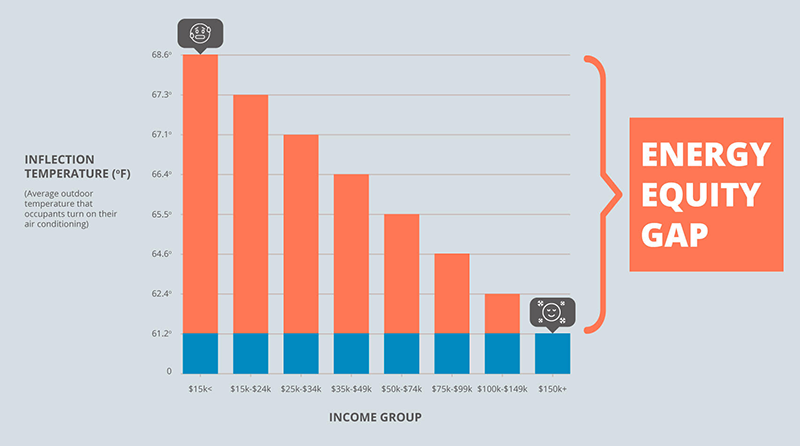Hidden energy poverty revealed by energy equity gap
Energy equity gap provides new metric that captures resident behavior to illustrate the divide in safety and comfort from extreme temperatures across income groups.
Destenie Nock and Shuchen Cong are unveiling hidden energy poverty and insecurity. Their new metric developed with collaborators at the University of Maryland and the Salt River Project illustrates what they’ve termed the “energy equity gap.”
In industrialized regions, income is often used as a metric for energy poverty. Yet, income-based metrics fail to capture customer behavior that may also provide an indicator for energy poverty (lack of energy services or low consumption) and energy insecurity (inability to meet household energy needs). Having observed this drawback, Nock, assistant professor of civil and environmental engineering (CEE) and engineering and public policy (EPP), and Cong, a Ph.D. student in EPP, and their team set out to create an energy equity metric that illustrates the socioeconomic divide in access to energy.
To do this, Nock and her co-authors’ primary data point for each household was its inflection point, or the outdoor temperature at which occupants turned on cooling systems. By separating households by income group, a consistent pattern begins to appear, with each increase in income corresponding to a lower inflection point. Measuring the difference in inflection point between the lowest income group and the highest gives us Nock’s energy equity gap. In their study of customers in Arizona, they estimated that the energy equity gap was between 4.7°F and 7.5°F.
This means that when temperatures rise, low income customers in this region are forced to endure higher indoor temperatures for longer periods than those in the highest income group. Beyond comfort, heat-related illness is a serious threat in hot, arid regions like Arizona, which saw 2,944 emergency room visits for heat-related illness in 2019 alone. In colder regions, a similar inflection point may be found by measuring when households turn on their heating.

Source: College of Engineering
A representation of the energy equity gap based on data from 2,650 Arizona households from 2018-2019.
“Capturing energy-limiting behaviors is important for addressing and planning for energy justice, which hinges on the proper distribution of benefits for a clean energy transition, and an ability to mitigate the effect of heatwaves,” said Nock and co-authors.
Rather than a replacement, the energy equity gap is an excellent complement to current income-based metrics, capturing a previously unseen group experiencing energy insecurity without much overlap. Of 4,577 households examined from 2015-2016, the energy equity gap showed 86 energy-poor and 214 energy-insecure households. Only three of these were captured in the 141 households identified as energy-poor by existing income-based metrics, revealing significantly more challenges for energy access than previously known. Data from smart sensors could further enhance models by providing usage data in frequent increments and even from different appliances, helping understand the lived experience for occupants.
Energy usage is the inequity that we should be focusing on, and that can’t be found with solely an income-based measure.”
Destenie Nock, Assistant Professor, Civil and Environmental Engineering and Engineering and Public Policy
A broader view of energy poverty and energy insecurity should motivate policy that creates a more equitable distribution of energy consumption. Currently, a federal program provides direct financial energy assistance to low income families. This assistance is important, but the energy equity gap suggests other policy measures may also help shrink the energy divide. For instance, Nock suggests that policy makers could institute a demand-response program that reroutes excess energy from elsewhere in the grid, to customers whose energy needs are currently unmet. Policy like this requires the type of behavior data provided in Nock and Cong’s research, as well as direct input on temperature preference and comfort from households.
Nock advises that there are still significant challenges to achieving a common understanding of energy equity. Adapting to the additional heatwaves spurred by climate change will require us to address inequities in comfort, which has a direct tie to productivity within the home. This has direct implications for the remote work practices and policies that have grown since the COVID pandemic.
“I think there’s a need to understand how inequitable the system is,” says Nock. “Energy usage is the inequity that we should be focusing on, and that can’t be found with solely an income-based measure.”
